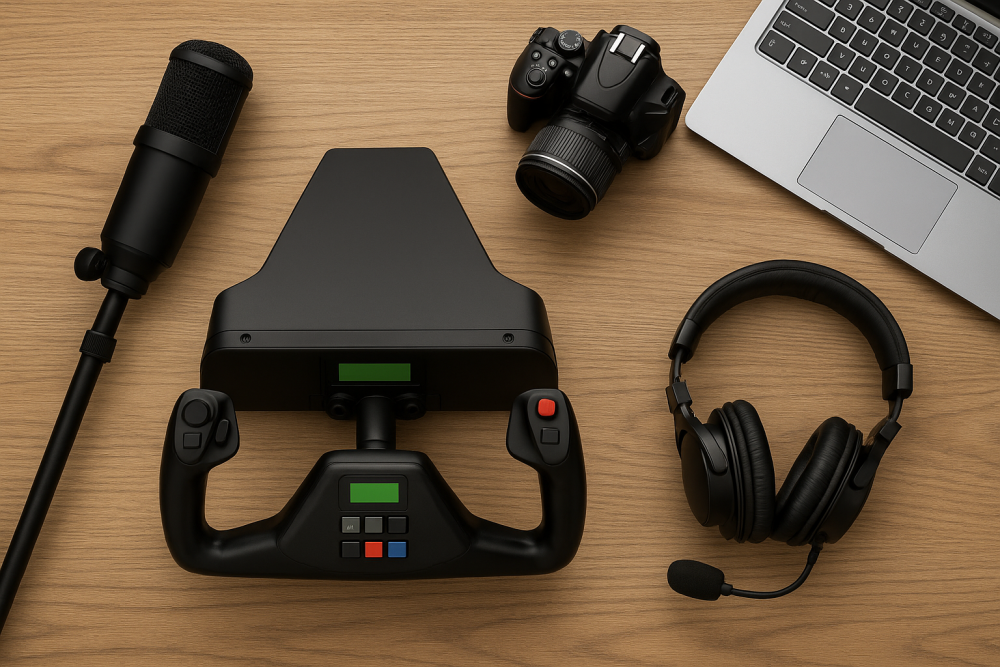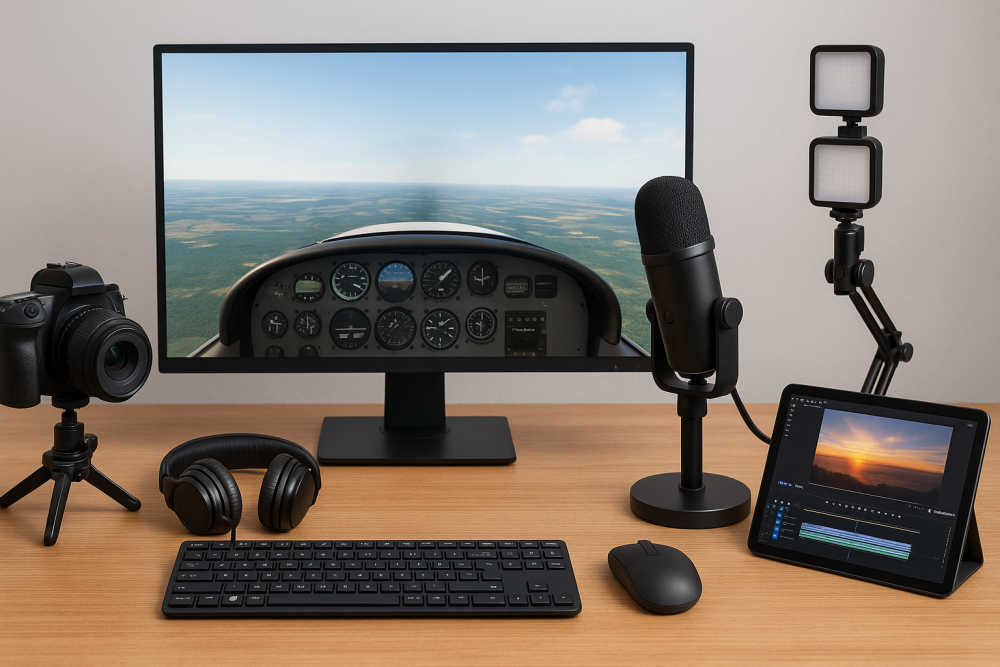Last updated on September 5th, 2025 at 11:36 pm

Starting your flight sim blog or vlog begins with knowing who you’re speaking to. Are you helping complete beginners take their first virtual flight, or are you guiding experienced simmers who want to fine-tune their skills? Identifying your audience early makes it easier to shape your content, from how technical your tutorials are to which topics will matter most to them.
Whether it’s launching into tutorials that guide beginners step-by-step, diving into in-depth reviews of add-ons, or showcasing the latest in-flight hardware, picking a solid niche makes your content relatable and useful. If you’re new to add-ons, check out our Understanding Add-Ons: Must-Have Software Enhancements Hardware reviews, for instance, can draw in tech-savvy simmers keen on upgrading their setup, while community engagement topics might attract those looking to connect with fellow enthusiasts.
Your personal experiences and insights are golden nuggets. Sharing a tale from your first flight or a mishap during a simulation doesn’t just make your content personal; it shows credibility and relatability. Nothing beats authentic stories to captivate your readers or viewers, making them feel like a part of your journey.
But how do you know you’re hitting the right mark? Surveys and feedback from your audience are powerful tools. They help you tailor your content to meet their interests, ensuring you keep them engaged while also giving you room to explore new areas as your audience expands.
Figuring out your niche isn’t about narrowing your scope; it’s opening up a channel where your passion meets your audience’s needs. And frankly, that’s where the magic happens in creating content that resonates.
Selecting Platforms: Where to Host Your Flight Journey

Picking the right platform for your flight sim content is like choosing the right runway: it sets the tone for your entire experience. Blogs and vlogs each have their perks, and finding the right mix could skyrocket your reach.
If you enjoy writing in-depth guides and tutorials, WordPress is an excellent choice. It gives you plenty of flexibility to customize your blog and present your content with clean, professional visuals. Whether you’re breaking down flight sim setups, reviewing hardware, or sharing tips, WordPress makes it easy to organize your articles in a way that’s both reader-friendly and SEO-friendly.
For those who thrive in front of the camera, YouTube and Twitch are where you’ll want to be. They allow for real-time interaction and dynamic storytelling, which is perfect for showing live flight sessions or unboxing the latest gadgets. Not only can you share your experiences visually, but you can also engage with your audience through comments and live chats.
You don’t have to choose between blogging and vlogging — using both together can really amplify your reach. For example, you could write a detailed tutorial on your blog and then create a step-by-step video showing it in action. This approach caters to different learning styles and also increases your visibility on Google, YouTube, and other search platforms.
Balancing multiple platforms isn’t without challenges. Consistency in posting schedules and maintaining a unified style is key. Developing a cohesive strategy for both your blog and vlog will ensure your audience gets the best experience, no matter where they find you.
Lastly, get familiar with the technical ins and outs of hosting and streaming. Whether it’s figuring out the best settings for video quality or ensuring your blog loads swiftly, nailing these elements ensures a smooth flight for both you and your audience.
Crafting Compelling Content Plans: Balance and Creativity
Building a strong content plan isn’t about pumping out as many posts as possible — it’s about finding the right mix of evergreen guides that stay useful over time and timely updates that keep your blog or vlog fresh. This balance helps you attract both new readers looking for trends and returning followers who rely on your ongoing tips.
Evergreen content — like beginner tutorials, setup guides, and basic tips — gives your audience lasting value. These are the go-to resources people will revisit whenever they need help, making them the foundation of your blog or vlog.
Mix in timely updates alongside your evergreen content to keep things fresh. For example, you could cover new Microsoft Flight Simulator features or upcoming X-Plane releases. Posting about trending topics helps you attract new visitors while showing your audience that you’re up to date with the latest in flight sim tech.
Squeeze in some comparisons and reviews too – — for example, analyzing setups in your Best Joysticks for a Realistic Flight Experience article or reviewing flight sim add-ons. These pieces guide your audience’s choices and keep them coming back for more.
Everyone loves a good saga. Plan series content where you take followers on a journey—maybe building your ultimate virtual rig part by part or a weekly series tackling different flight maneuvers. Keeping content varied and consistent entertains and educates, boosting retention.
Don’t forget the visuals! Stunning screenshots, flight video snippets, and eye-catching thumbnails make your audience stop the scroll and click your content first.
Data-driven choices refine your strategy. Tapping into analytics highlights which types of content hit the mark and which may need tweaking, helping optimize future posts.
Equipping Yourself: Tools and Gear for Quality Content

Your gear plays a big role in the quality of your content, but you don’t need the most expensive setup to get started. Think of it like preparing your digital cockpit — a good microphone, clear visuals, and smooth recordings create a better experience for your viewers without breaking the bank.
First off, you’ll need a reliable microphone. Clear audio is essential, particularly if you’re narrating tutorials or reviews. A good starter list is included in our Essential Hardware Upgrades Guide. Your audience should hear every word, no static or fuzz allowed.
A quality camera comes next. Whether you’re recording your reactions or showcasing hardware, sharp and crisp visuals draw viewers in. For screen capturing, invest in top-tier software that records in high definition and won’t lag your system during crucial moments — especially if you’re planning to feature setups like those in Building a DIY Home Cockpit on a Budget.
Lighting, often overlooked, plays a huge role in video quality. A well-lit setup makes everything look more professional and polished. Even basic lighting kits can drastically upgrade the look of your content.
Editing software can turn raw footage into polished content. Whether it’s snipping unwanted seconds or adding graphics, solid editing turns good content great. And don’t overlook cockpit visuals, as realistic or unique setups captivate audience attention.
The good news is you don’t need the fanciest gear right out of the gate. Many creators start with budget-friendly tools and upgrade as their audience—and income—grows. Focus on what adds genuine improvement to your content.
Growing and Monetizing Your Sim Enthusiast Following
Growing your audience is only the first step — the real challenge is turning that following into something sustainable. One of the easiest ways to start is with affiliate programs from trusted brands like Thrustmaster, Honeycomb Aeronautical or Amazon. Recommending gear you’ve personally tested, like those in our Best Throttle Quadrants Guide builds trust and drives conversions. It’s a simple way to support your work while giving your audience trusted, experience-based recommendations.
Don’t just stop there, though. Adsense offers a straightforward way to get ads on your blog or vlog, but remember it works best with substantial traffic. For creators with a loyal fanbase, personalized merchandising or funding platforms like Patreon open new revenue streams. Your fans support you, and you reward them with exclusive content or recognition.
Engagement is what turns casual visitors into loyal followers. Get involved in forums like Discord groups and top flight sim communities where enthusiasts share tips, setups, and experiences. These spaces aren’t just great for connecting — they also give you direct feedback on what your audience wants, helping you create content that truly resonates.
Optimize your content for search engines using savvy SEO techniques. Use keywords strategically in your titles and descriptions, and don’t forget those alt texts for all your images. Internal linking within your content also boosts your site’s authority and keeps readers clicking through multiple pages of your site or channel.
Tracking growth constantly helps refine your strategy. Google Analytics and Search Console aren’t just there to fill your brain with data. They show what’s working and what isn’t, guiding your next moves in the ever-changing space of content creation.
Conclusion: Take the First Step Toward Your Flight Sim Blog or Vlog ✈️
Starting a flight sim blog or vlog is your chance to share your passion, inspire others, and become part of a growing community of virtual aviators. From tutorials and hardware reviews to cockpit showcases, your unique insights can help others make the most of their simulation experience.
Now’s the perfect time to take off — choose your niche, pick your platform, and start crafting content that reflects your journey. And if you’re looking to grow your audience faster, consider exploring multiplayer events and group flights where simmers collaborate and share experiences.
Got a story, tip, or question to share? Join the conversation in the comments below and connect with fellow creators who share your love for flight simulation. 🚀
